Monarch Butterfly
- February 29, 2024
- 0 comment
The Monarch Butterfly, scientifically known as Danaus plexippus, is a fascinating and iconic insect species native to North and Central America. Renowned for its vibrant orange and black wings, the Monarch Butterfly holds a special place in the hearts of nature enthusiasts worldwide. What sets the Monarch apart is not just its striking appearance but also its remarkable life cycle and migration patterns. From the moment it emerges from its chrysalis as a delicate butterfly, the Monarch embarks on an incredible journey, traveling thousands of miles during its annual migrations.
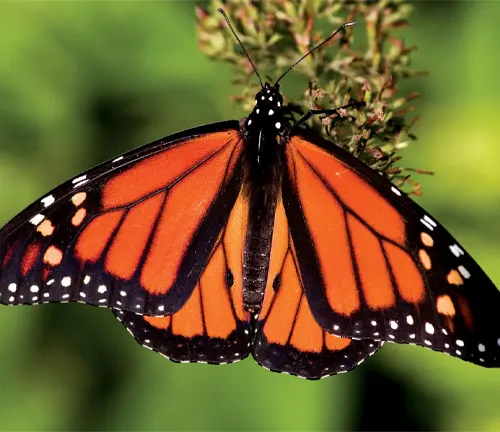
These migrations, which occur between overwintering sites in Mexico or California and breeding grounds in North America, are one of the most extraordinary phenomena in the natural world. However, the Monarch Butterfly faces numerous threats to its survival, including habitat loss, climate change, pesticides, and disease. Despite these challenges, dedicated conservation efforts aim to protect and preserve the Monarch’s habitat and migration routes.
By planting milkweed, creating butterfly-friendly gardens, and advocating for policies that support Monarch conservation, individuals can play a vital role in ensuring the continued survival of this majestic insect. The Monarch Butterfly serves as a symbol of beauty, resilience, and the interconnectedness of all living things, reminding us of the importance of safeguarding our natural world for future generations to enjoy.
| Specification | Details |
|---|---|
| Scientific Name | Danaus plexippus |
| Common Name | Monarch Butterfly |
| Family | Nymphalidae |
| Wingspan | 3.7 to 4.1 inches (9.4 to 10.4 cm) |
| Color | Vibrant orange with black veins and borders |
| Range | North and Central America |
| Habitat | Various habitats, including meadows, fields, gardens |
| Life Cycle | Egg, Larva (Caterpillar), Pupa (Chrysalis), Adult |
| Migration | Annual migration between overwintering and breeding grounds |
| Migration Distance | Up to 3,000 miles (4,800 km) |
| Overwintering Sites | Oyamel fir forests in Mexico, Eucalyptus groves in California |
| Diet | Larvae feed exclusively on milkweed plants; adults feed on nectar from flowers |
| Threats | Habitat loss, climate change, pesticides, disease |
| Conservation Efforts | Planting milkweed, creating butterfly-friendly gardens, advocating for policies supporting conservation |
| Symbolism | Beauty, resilience, interconnectedness of nature |
Nature’s Majestic Wanderers
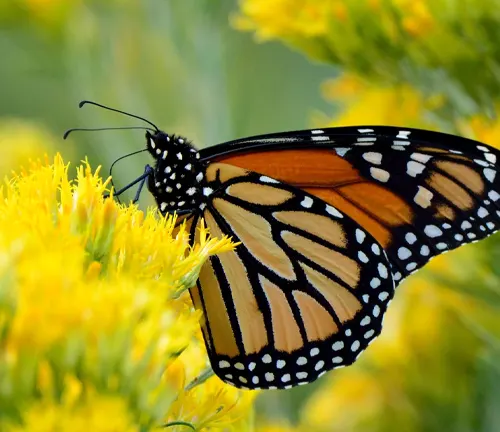
Butterflies are among the most enchanting creatures in the natural world, captivating us with their vibrant colors and graceful flight. Among them, the Monarch Butterfly (Danaus plexippus) stands out as a symbol of beauty and resilience. In this article, we’ll delve into the fascinating world of Monarch Butterflies, exploring their life cycle, migration patterns, habitat, threats, conservation efforts, and how you can attract them to your garden.
What are Monarch Butterflies?
Monarch Butterflies are renowned for their distinctive orange and black wings, making them easily recognizable. They belong to the family Nymphalidae and are found primarily in North America.
Monarch Butterflies play a crucial role in ecosystems as pollinators and indicators of environmental health. Their presence enriches biodiversity and contributes to the beauty of nature.
Life Cycle of Monarch Butterflies
Egg Stage
The life cycle of a Monarch Butterfly begins with the egg stage. Female Monarchs lay their eggs on the leaves of milkweed plants, which serve as the sole food source for Monarch caterpillars. The eggs are small, oval-shaped, and pale in color, typically laid singly on the underside of milkweed leaves.

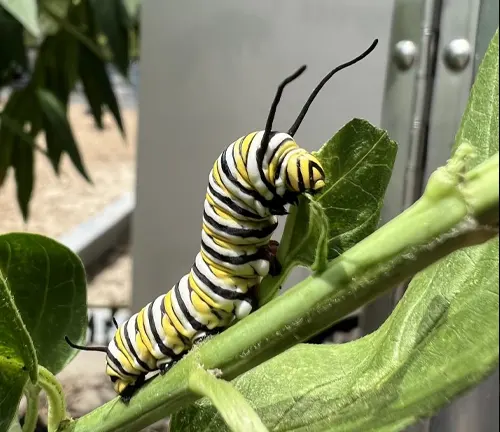
Larva Stage
After about 3 to 5 days, the eggs hatch, giving rise to larvae known as caterpillars. Monarch caterpillars have distinct black, yellow, and white stripes and feed voraciously on milkweed leaves to fuel their rapid growth. During this stage, they molt several times, shedding their exoskeletons to accommodate their increasing size.
Pupa Stage
Once the caterpillar reaches full size, it enters the pupa stage, also known as the chrysalis stage. The caterpillar attaches itself to a secure surface, such as a twig or stem, and forms a protective casing around itself called a chrysalis. Inside the chrysalis, the caterpillar undergoes metamorphosis, transforming into a butterfly over the course of about 10 to 14 days.
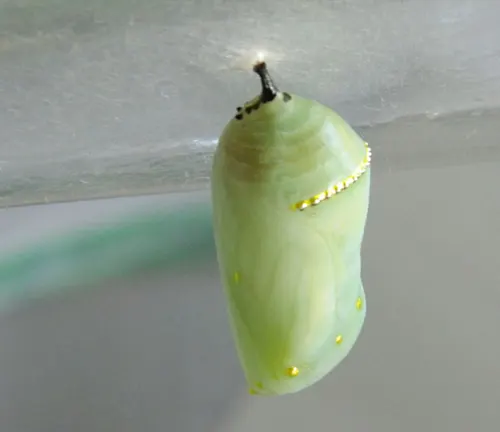
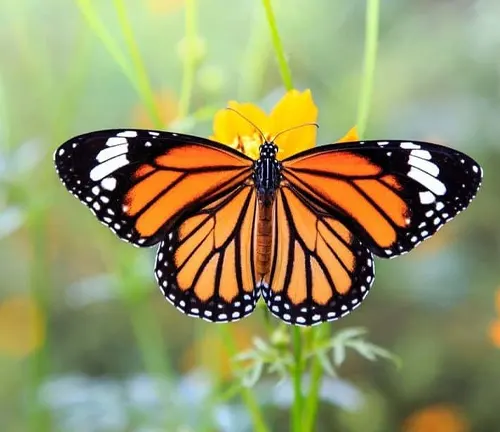
Adult Stage
After completing metamorphosis, the adult Monarch Butterfly emerges from the chrysalis. Initially, its wings are soft and crumpled, but within a few hours, they expand and harden, allowing the butterfly to fly. Adult Monarchs feed primarily on nectar from flowers, using their long proboscis to sip the sweet liquid. During this stage, they also engage in mating and reproduction, continuing the life cycle by laying eggs for the next generation of Monarchs.
Migration Patterns of Monarch Butterflies

Northward Migration
The Northward Migration of Monarch Butterflies occurs in the spring months, typically from March to June, depending on the region. During this migration, Monarchs travel from their overwintering sites in Mexico or coastal California to their breeding grounds in North America. As temperatures warm and daylight hours increase, Monarchs begin their journey northward, seeking milkweed plants to lay their eggs. They follow specific migration routes, covering vast distances and traversing diverse landscapes. Along the way, they stop to rest and refuel on nectar from flowers, helping sustain them on their long journey. Northward migration plays a crucial role in the Monarch life cycle, as it allows Monarchs to populate new areas and expand their breeding range.
Southward Migration
The Southward Migration of Monarch Butterflies takes place in the autumn months, typically from September to November. As temperatures cool and daylight hours decrease, Monarchs begin their journey southward, returning to their overwintering sites in Mexico or coastal California. The Southward Migration is triggered by changes in environmental conditions, including declining temperatures and decreasing food availability. Monarchs gather in large numbers at overwintering sites, forming dense clusters in oyamel fir forests in Mexico or eucalyptus groves in California. Here, they remain in a state of dormancy, conserving energy until the arrival of spring prompts them to begin the cycle anew. Southward migration is essential for Monarchs to escape harsh winter conditions and ensure their survival until the following spring.
Habitat and Range of Monarch Butterflies
Native Range
The native range of Monarch Butterflies encompasses North and Central America. They are found throughout much of the continent, from southern Canada to northern South America. Monarchs are most commonly associated with the United States, where they are widespread and abundant, but they also inhabit regions of Mexico, Central America, and the Caribbean. Within their native range, Monarchs occupy a variety of habitats, including meadows, fields, gardens, and coastal areas, where they find suitable food and breeding grounds.
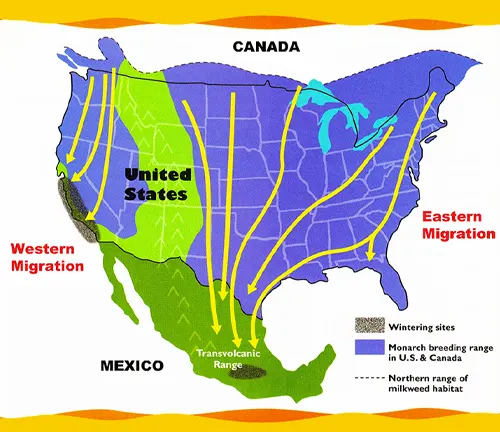
Migration Routes
Monarch Butterflies undertake annual migrations between their breeding grounds in North America and their overwintering sites in Mexico or coastal California. The migration routes of Monarchs cover vast distances, spanning thousands of miles. In the spring, Monarchs follow northward migration routes from their overwintering sites, traveling through the United States and Canada to reach their breeding grounds. In the autumn, they return southward along similar migration routes, guided by environmental cues and celestial navigation. These migration routes traverse diverse landscapes and ecosystems, including forests, prairies, and urban areas.
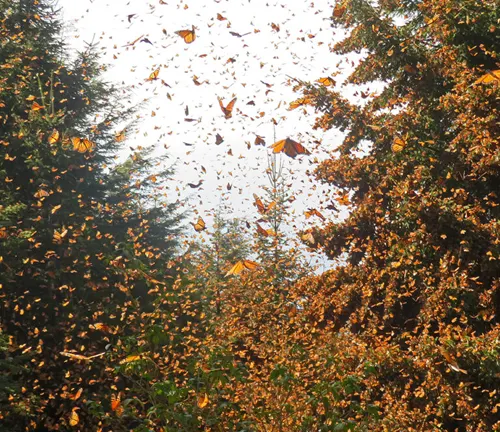
Overwintering Sites
Monarch Butterflies overwinter in specific sites that provide shelter from harsh winter conditions. In Mexico, Monarchs congregate in oyamel fir forests located in the Transvolcanic Belt of central Mexico, primarily in the states of Michoacán and Mexico. These forests, situated at high elevations, offer a favorable microclimate for overwintering Monarchs, with stable temperatures and humidity levels. In coastal California, Monarchs gather in eucalyptus groves along the Pacific coast, seeking refuge from winter storms and cold temperatures. These overwintering sites provide essential habitat for Monarchs to survive the winter months until the arrival of spring prompts them to resume their migratory journey.
Threats to Monarch Butterflies
Habitat Loss
Habitat loss is one of the most significant threats to Monarch Butterflies. The destruction and fragmentation of habitat, particularly the loss of milkweed plants, which serve as the sole food source for Monarch caterpillars, have detrimental effects on Monarch populations. Factors contributing to habitat loss include urbanization, agricultural expansion, deforestation, and land development. As natural habitats diminish, Monarchs struggle to find suitable breeding grounds and nectar sources, leading to declines in population numbers.
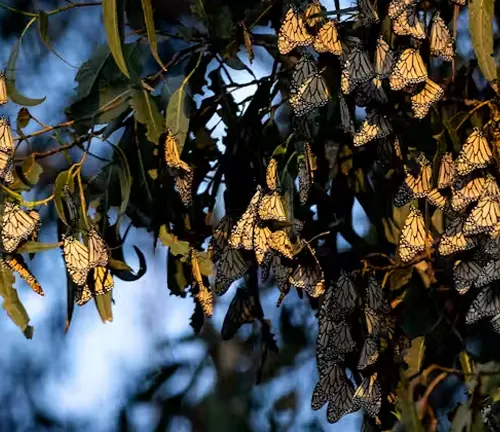
Climate Change
Climate change poses a significant threat to Monarch Butterflies and their habitats. Rising temperatures, altered precipitation patterns, and extreme weather events can disrupt the Monarch’s life cycle, migration patterns, and food availability. Changes in climate can affect the timing of Monarch migration, the availability of milkweed and nectar plants, and the suitability of overwintering sites. These disruptions can have cascading effects on Monarch populations, leading to reduced survival rates and population declines.
Pesticides
Pesticides, particularly insecticides, pose a serious threat to Monarch Butterflies. Chemicals such as neonicotinoids and glyphosate, commonly used in agriculture and landscaping, can contaminate milkweed plants and other flowering species that Monarchs rely on for food. Exposure to pesticides can weaken Monarchs, disrupt their reproductive behavior, and reduce their overall fitness. Additionally, pesticides can indirectly harm Monarchs by eliminating other insect species that serve as their food sources or prey on pest species.

Disease
Disease is another factor contributing to the decline of Monarch Butterflies. One significant disease affecting Monarchs is caused by the protozoan parasite Ophryocystis elektroscirrha (OE). Infected Monarchs may exhibit symptoms such as reduced lifespan, weakened flight, and deformed wings. OE can spread among Monarchs through contact with contaminated surfaces or infected individuals, particularly in dense populations at overwintering sites. Disease outbreaks can lead to increased mortality rates and further stress on Monarch populations already facing other threats.
Conservation Efforts for Monarch Butterflies
Planting Milkweed
Planting milkweed is a crucial conservation effort to support Monarch Butterflies throughout their life cycle. Milkweed serves as the sole food source for Monarch caterpillars, providing essential nutrients for their growth and development. By cultivating milkweed in gardens, parks, and natural areas, individuals can create habitat corridors and breeding grounds for Monarchs. Planting native milkweed species that are adapted to local conditions helps ensure their suitability for Monarch larvae and supports healthy populations.
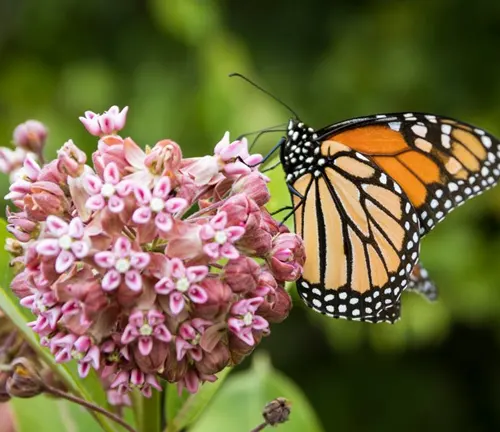
Creating Monarch Waystations
Monarch Waystations are designated areas that provide essential resources for Monarch Butterflies during their migration journey. These waystations typically include milkweed plants for breeding and nectar-rich flowers for feeding. By creating Monarch Waystations in urban, suburban, and rural landscapes, individuals, communities, and organizations can contribute to the conservation of Monarchs and other pollinators. These waystations serve as rest stops and refueling stations for migrating Monarchs, helping them complete their journey successfully.
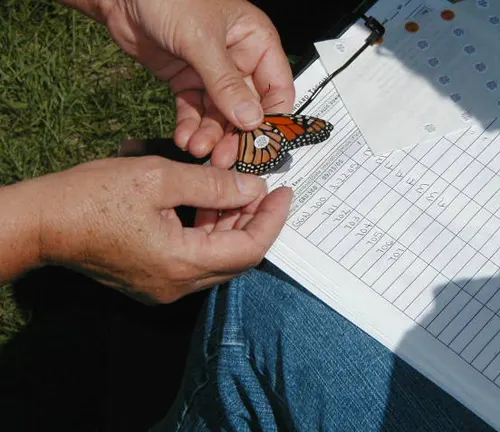
Citizen Science Projects
Engaging the public in citizen science projects is an effective way to involve individuals in monitoring Monarch populations and habitat conditions. Citizen scientists can contribute valuable data on Monarch sightings, migration patterns, and breeding success through observation, data collection, and reporting. Participating in citizen science initiatives empowers individuals to make meaningful contributions to Monarch conservation efforts while increasing awareness and appreciation for these iconic insects.
Policy Initiatives
Implementing policy initiatives at local, regional, and national levels is essential for the long-term conservation of Monarch Butterflies. Policy measures may include habitat protection and restoration, pesticide regulations, land-use planning, and incentives for conservation practices. By enacting policies that prioritize Monarch habitat conservation, governments and policymakers can help address the underlying causes of population declines and ensure the preservation of Monarch populations for future generations.
Fun Facts About Monarch Butterflies
- Monarchs undertake one of the longest insect migrations in the world, traveling up to 3,000 miles.
- They can travel at speeds of up to 12 miles per hour during migration.
- Monarchs use a combination of environmental cues and celestial navigation to navigate their migration routes.
- The distinctive coloration of Monarchs serves as a warning to predators, signaling their toxicity due to the ingestion of milkweed toxins.
- Despite their delicate appearance, Monarch Butterflies are strong fliers, capable of covering vast distances.
Different Species
Queen Butterfly
(Danaus gilippus)
The Queen Butterfly is closely related to the Monarch and shares a similar appearance, with orange wings adorned with black veins and borders. However, it is slightly smaller than the Monarch and lacks the distinctive white spots found on the Monarch’s wings.
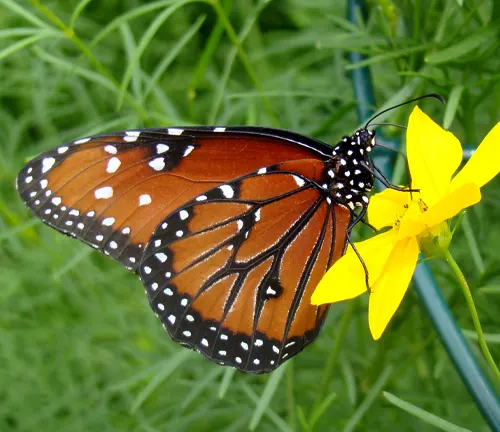
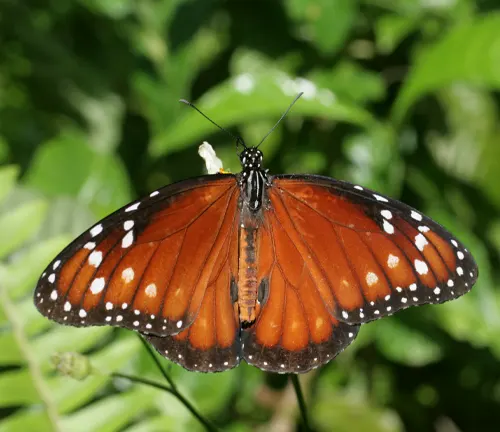
Soldier Butterfly
(Danaus eresimus)
Also known as the Tropical Queen Butterfly, the Soldier Butterfly is another species within the Danaus genus. It has similar coloration to the Monarch and Queen butterflies but is primarily found in tropical regions of the Americas.
Plain Tiger Butterfly
(Danaus chrysippus)
While not native to the Americas like the Monarch, the Plain Tiger Butterfly belongs to the same genus, Danaus. It is found in parts of Africa, Asia, and Australia and shares the Monarch’s vibrant orange coloration, though with different patterns on its wings.

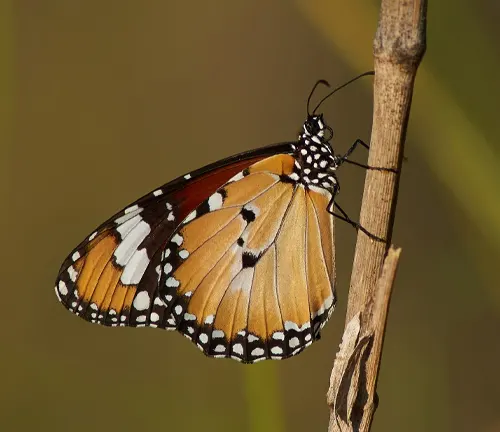
Lesser Wanderer Butterfly
(Danaus petilia)
Found in Australia and parts of Southeast Asia, the Lesser Wanderer Butterfly is another member of the Danaus genus. It resembles the Monarch in appearance, with orange wings and black markings, but it is smaller in size.
Frequently Asked Questions (FAQs)
- Why are Monarch Butterflies declining in population?
Monarch Butterflies face various threats to their survival, including habitat loss, climate change, pesticide use, and disease. These factors have contributed to declines in Monarch populations in recent years. - How far do Monarch Butterflies migrate?
Monarch Butterflies undertake one of the longest insect migrations in the world, traveling thousands of miles between their overwintering sites in Mexico or California and their breeding grounds in North America. - What is the lifespan of a Monarch Butterfly?
The lifespan of a Monarch Butterfly varies depending on factors such as environmental conditions and predation. On average, adult Monarchs live for 2 to 6 weeks, while the entire life cycle from egg to adult typically takes about 4 to 6 weeks. - How do Monarchs avoid predators during migration?
Monarch Butterflies use their bright orange and black coloration as a warning signal to predators, indicating their toxicity due to the ingestion of milkweed toxins. This defense mechanism helps deter predators from attacking them. - Do Monarch Butterflies migrate in groups?
During migration, Monarch Butterflies often form large aggregations or clusters at overwintering sites in Mexico or California. However, they do not migrate in cohesive groups like birds but instead follow similar migration routes individually or in small groups. - What role do Monarch Butterflies play in ecosystems?
Monarch Butterflies serve as important pollinators, helping to facilitate the reproduction of flowering plants. They also play a vital role in food webs as prey for various predators, contributing to ecosystem dynamics and stability. - How do Monarch Butterflies find their overwintering sites?
Monarch Butterflies use a combination of innate behaviors and environmental cues to locate their overwintering sites. These cues may include celestial navigation, geomagnetic fields, and the recognition of specific landmarks along their migration routes. - Can I raise Monarch Butterflies at home?
Yes, it is possible to raise Monarch Butterflies at home by collecting Monarch eggs or caterpillars from milkweed plants and providing them with a suitable rearing environment until they emerge as adults. However, it is essential to follow proper rearing practices to ensure their health and well-being. - How do Monarch Butterflies contribute to the economy?
Monarch Butterflies contribute to ecotourism and local economies through activities such as butterfly watching tours, festivals, and the sale of butterfly-related merchandise. Their presence can also enhance the value of natural areas for recreation and tourism. - Are Monarch Butterflies affected by climate change?
Yes, climate change can impact Monarch Butterflies by altering weather patterns, affecting the availability of milkweed and nectar plants, and disrupting migration timing and routes. These changes can have significant implications for Monarch populations and their long-term survival. - What are the differences between male and female Monarch Butterflies?
Male and female Monarch Butterflies can be distinguished by subtle differences in their wing markings and size. Males typically have thinner black veins on their wings and a small black spot on each hindwing, while females have thicker veins and a larger abdomen for egg production.


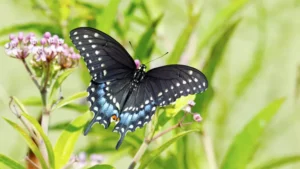
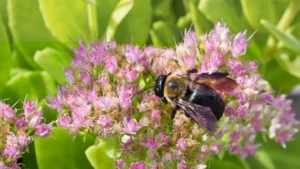

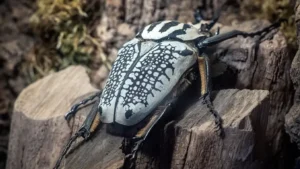
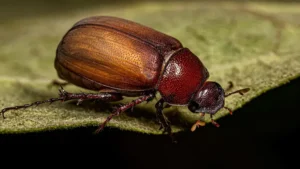

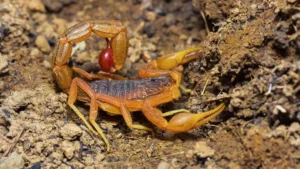
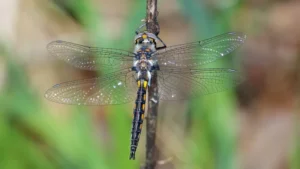
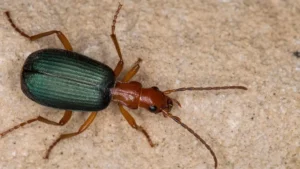
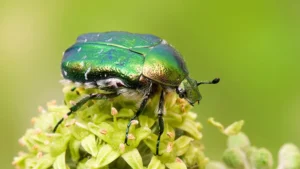


Leave your comment